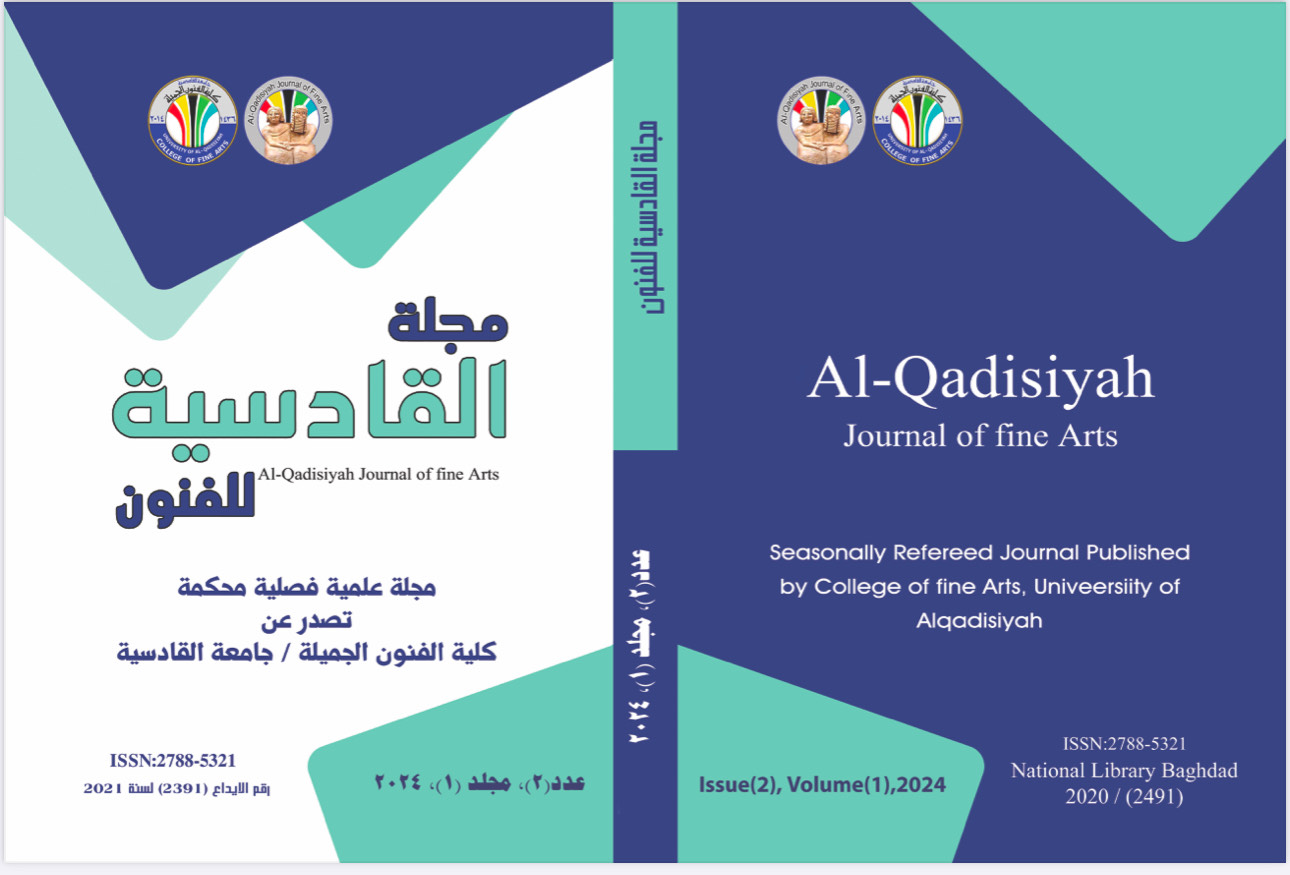Abstract
.
Abstract:
We conclude from the foregoing that ugliness constitutes a pattern opposite to everything that is beautiful in drama and life in general. But at the level of the arts, such as theatrical discourse, it serves as the objective equivalent as a means of expressing ideas, attitudes, and events according to abstract artistic formulas, based on the fact that ugly has negative values, but it has aesthetic returns when it is treated according to different innovative visions, while the beautiful represents the sublime rank related to the concepts of right and good. Harmony and enjoyment after it are a creative value, and that the aesthetic of ugliness depends on the nature of the approaches searching for the generators of beauty, if we realize that ugliness is an aesthetic saying because of the artistic motives it contains that multiply the expressive and aesthetic patterns in theatrical discourse. As long as ugliness was employed in drama of all kinds, it was part of its structural and aesthetic structure, with our knowledge that the theater director does not carry ugliness, or so he assumes, but rather takes from it an expressive material and then adds his feelings and imagination to it to produce a beautiful and amazing work that arouses interest due to its unfamiliarity or strangeness, so the aesthetic response is achieved between the audience and the show. Therefore, we recommend that the faculties of fine arts give more theses and theses related to ugliness and its aesthetic exceptional importance, and that ugliness be studied as an aesthetic pattern in theatrical texts and performances.
Keywords: aesthetic, ugliness, theatrical preformance.
Abstract:
We conclude from the foregoing that ugliness constitutes a pattern opposite to everything that is beautiful in drama and life in general. But at the level of the arts, such as theatrical discourse, it serves as the objective equivalent as a means of expressing ideas, attitudes, and events according to abstract artistic formulas, based on the fact that ugly has negative values, but it has aesthetic returns when it is treated according to different innovative visions, while the beautiful represents the sublime rank related to the concepts of right and good. Harmony and enjoyment after it are a creative value, and that the aesthetic of ugliness depends on the nature of the approaches searching for the generators of beauty, if we realize that ugliness is an aesthetic saying because of the artistic motives it contains that multiply the expressive and aesthetic patterns in theatrical discourse. As long as ugliness was employed in drama of all kinds, it was part of its structural and aesthetic structure, with our knowledge that the theater director does not carry ugliness, or so he assumes, but rather takes from it an expressive material and then adds his feelings and imagination to it to produce a beautiful and amazing work that arouses interest due to its unfamiliarity or strangeness, so the aesthetic response is achieved between the audience and the show. Therefore, we recommend that the faculties of fine arts give more theses and theses related to ugliness and its aesthetic exceptional importance, and that ugliness be studied as an aesthetic pattern in theatrical texts and performances.
Keywords: aesthetic, ugliness, theatrical preformance.
Keywords
Keywords: aesthetic
theatrical preformance.
ugliness
Abstract
ملخص البحث:
نخلص مما تقدم ان القبح يشكل نسقا مضادا لكل ما هو جميل في الدراما والحياة عامه. لكن على صعيد الفنون كالخطاب المسرحي يكون بمثابة المعادل الموضوعي بوصفه وسيلة للتعبير عن الافكار والمواقف والاحداث على وفق صيغ فنية مجرده انطلاقا من كون القبيح قيمة سلبية لكن له مردودات جمالية عندما يعالج على وفق رؤى تجديدية مغايرة في حين ان الجميل يمثل المرتبة السامية المتصلة بمفاهيم الحق والخير والانسجام والامتاع بعده قيمة إبداعية، وان استظهار جمالية القبح يتوقف على طبيعة المقاربات الباحثة عن مولدات الجمال اذا ما ادركنا ان القبح مقولة جمالية لما تنطوي عليه من بواعث فنية تضاعف الانساق التعبيرية والجمالية في الخطاب المسرحي، كما ان النقائض تعد اساس الجمال في الدراما منذ نشأتها والى الان، اذ طالما وظف القبح في الدراما بأنواعها كافة، فكان جزءا من هيكليتها البنيوية والجمالية مع علمنا بان المخرج المسرحي لا يحمل القبح او هكذا يفترض وانما يتخذ منه مادة تعبيرية ثم يضفي عليها مشاعره واخيلته لينتج عملا جميلا مدهشا يثير الاهتمام لعدم مألوفيته او لغرابته فتتحقق الاستجابة الجمالية بين الجمهور والعرض المسرحي، لذلك نوصي ان تولي كليات الفنون الجميلة تقديم المزيد من الرسائل والاطاريح الجامعية المتعلقة بالقبح وجماليته الاهمية الاستثنائية وان يدرس القبح بوصفه نسقا جماليا في النصوص والعروض المسرحي.
الكلمات المفتاحية: الجمالية، القبح، العرض المسرحي
نخلص مما تقدم ان القبح يشكل نسقا مضادا لكل ما هو جميل في الدراما والحياة عامه. لكن على صعيد الفنون كالخطاب المسرحي يكون بمثابة المعادل الموضوعي بوصفه وسيلة للتعبير عن الافكار والمواقف والاحداث على وفق صيغ فنية مجرده انطلاقا من كون القبيح قيمة سلبية لكن له مردودات جمالية عندما يعالج على وفق رؤى تجديدية مغايرة في حين ان الجميل يمثل المرتبة السامية المتصلة بمفاهيم الحق والخير والانسجام والامتاع بعده قيمة إبداعية، وان استظهار جمالية القبح يتوقف على طبيعة المقاربات الباحثة عن مولدات الجمال اذا ما ادركنا ان القبح مقولة جمالية لما تنطوي عليه من بواعث فنية تضاعف الانساق التعبيرية والجمالية في الخطاب المسرحي، كما ان النقائض تعد اساس الجمال في الدراما منذ نشأتها والى الان، اذ طالما وظف القبح في الدراما بأنواعها كافة، فكان جزءا من هيكليتها البنيوية والجمالية مع علمنا بان المخرج المسرحي لا يحمل القبح او هكذا يفترض وانما يتخذ منه مادة تعبيرية ثم يضفي عليها مشاعره واخيلته لينتج عملا جميلا مدهشا يثير الاهتمام لعدم مألوفيته او لغرابته فتتحقق الاستجابة الجمالية بين الجمهور والعرض المسرحي، لذلك نوصي ان تولي كليات الفنون الجميلة تقديم المزيد من الرسائل والاطاريح الجامعية المتعلقة بالقبح وجماليته الاهمية الاستثنائية وان يدرس القبح بوصفه نسقا جماليا في النصوص والعروض المسرحي.
الكلمات المفتاحية: الجمالية، القبح، العرض المسرحي
Keywords
الكلمات المفتاحية: الجمالية، القبح، العرض المسرحي
